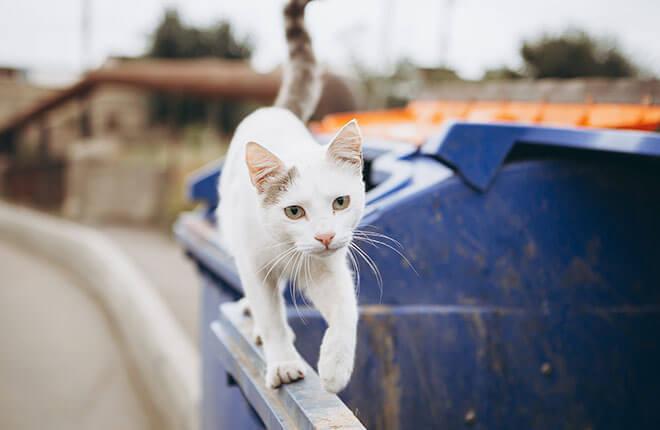If you love animals, you’ve probably had at least one of those moments where you see an unknown cat in your yard, a parking lot, or walking down the road, and think, “Does that stray kitty need help?” Then your mind starts to race, wondering how you’d catch the cat, whether it’s healthy, and if you have any place to keep them. It can be overwhelming if you don’t know what to do in these situations. Luckily, a little education and commitment can give you the confidence you need to help a stray cat in need.

How Do You Know If a Cat Is a Stray?
While there is some fluidity in the definitions, the term “stray” generally refers to a cat who is lost or displaced from their home. Feral cats, on the other hand, were born wild or spent much of their life on their own and are not well socialized to people.
But how do you know if a cat is technically stray? This is an easier question to answer for dogs because, generally, if you see a dog running loose, it’s either an escapee from a home or it’s homeless (stray). Cats, however, have a different relationship with the outdoors and the perimeter of their home. If allowed outside, they’re more likely to roam beyond their yard, making it difficult to know whether you’re dealing with a stray cat in need of rescue or your neighbor’s cat out for a stroll.
Cats are very clean animals by nature, but a stray cat may have a tougher time keeping themselves clean if they’re living outdoors. A wet and/or dirty cat can be an initial indicator that they may be stray.
The best way to determine if a cat has an owner, assuming they’re not wearing I.D. tags, is to take them to a veterinary clinic or animal shelter to be scanned for an I.D. microchip. Unfortunately, this means catching them first, which we’ll get to. If they have a microchip, the animal shelter or vet clinic can look up the microchip company to contact to identify the cat’s owner. Checking for a microchip is a good first step, but if they don’t have a chip, it doesn’t mean they don’t have an owner.
Often if a cat is lost, their owner(s) may put up missing pet fliers, post on missing pet social media sites, and/or have lost pet e-mail notifications sent out to local vet clinics and animal shelters by their microchip company, if applicable. Looking for the cat on area bulletin boards and on missing pet social media sites, as well as calling area vet hospitals and animal rescues to see if they are aware of a missing cat matching the description can also be helpful steps.
How to Catch a Stray Cat
Getting your hands on a stray kitty can be as easy as opening your front door or as difficult as luring them into a humane trap over days, weeks, or even months. Some strays practically walk up and ask you to save them. If you have a timid stray, you may be able to spend a few days or weeks sitting outside while they’re around, offering food and talking quietly, in hopes of gaining their trust so you can easily take them in. Be careful because even a friendly stray cat can become upset when you try and catch them and end up scratching or biting you. Anytime you are bit or scratched by a stray cat, you must contact your physician immediately.
For more difficult cases, you can buy or borrow a humane spring trap — sometimes local animal rescues have such traps available for rental. These are long, rectangular cages with spring-loaded doors. You bait the trap with something stinky that cats like (like sardines), wait for them to step inside, and the door shuts behind them. There are a few important things to consider here:
- You need to be watching the trap. If a cat is locked inside and you’re not there to bring them in quickly, they can become dehydrated, suffer from heatstroke, and even attract predators.
- They’re likely to be very scared in the trap and could hurt themselves trying to escape if not secured quickly.
- You could easily catch the wrong animal. Raccoons, possums, skunks, and other critters will smell the food and may step into your trap. Have a plan in place to let them out while keeping yourself safe. You may want to keep Animal Control’s number handy. Exposing yourself to wildlife can also mean exposing yourself to dangers like rabies.
- Keep in mind that a frightened stray cat may bite or scratch, even though you're trying to help them. Cat bites and scratches can become infected and can transmit dangerous diseases, like rabies. Take care to keep yourself safe when approaching and handling a stray cat, and if needed get professional assistance from an animal control officer or experienced rescue worker if possible.
What to Do After You Catch a Stray Cat
The next steps in this process are very important. Even if a stray cat looks healthy you need to bring them to the veterinarian before you handle them or have them in your home. They could have parasites or more serious infectious diseases that could spread to your other pets and even you. So how you handle the initial hours and days with your rescued cat can impact their wellbeing, not to mention yours and that of any other pets you have at home.
If the cat is injured or appears unwell, it’s essential to get them to a rescue facility, veterinary clinic, or veterinary emergency room right away. Many of these cats are dehydrated (especially in warm weather months) and malnourished. There are also many injuries, illnesses, and diseases that can only be diagnosed by a trained professional. Be sure to call ahead and make sure they handle these types of cases and have space available.
If the cat seems to be in good health, you want to get them into a secure room. This is not the time to introduce them to your pets or family members. Cats who spend prolonged periods outside are at risk for various parasites, viruses, and other things that may be easily spread to people or animals. They may also be stressed or fearful. Give them a quiet room to rest and relax — someplace with hard surfaces that can be easily disinfected is best. Be sure to have food, water, and a litter box in the room as well. Dim the lights and give them some time to relax while you plan for the next steps. It may help to treat the room with a calming cat pheromone.
If you’re planning to surrender the cat to a rescue organization, reach out to make sure they have a space available and make arrangements. Most will not accept animals dropped off without approval. Never go straight to the rescue or veterinary clinic or leave an animal on their premises unattended or without notice.
If you’re planning to keep the cat, even temporarily, and they didn’t need immediate medical help, the first step is setting up an appointment with a veterinarian to have them checked out and scanned for their health and if they have a microchip. Your stray kitty should get a clean bill of health and be quarantined in their room for about two weeks before they’re allowed to meet other pets in your home or share space with them.
Your veterinarian may recommend a full physical examination and lab work, which may include a complete blood count and tests to check for feline immunodeficiency virus (FIV) and feline leukemia virus (FeLV). They will also recommend a fecal sample to check for intestinal parasites. Additionally, many stray cats can have ear mites or other types of ear infections. Based on the test results and exam findings, your veterinarian will recommend a vaccine protocol, deworming, medical treatments for any health issues diagnosed, and possible treatments for fleas, ticks, and heartworms.
This is also a good time to go through any necessary steps to find the cat’s owner if there is one. Be aware, in some areas, you are required to do your “due diligence” in trying to find the owner before you’re allowed to keep or rehome them. Look to your local pet rescue or county information website for any rules and regulations. You can post on local pet-finder sites or social media groups for lost pets by neighborhood, city, or county. If someone reaches out saying the cat is theirs, be cautious. Require proof like photographs, being able to describe distinguishing features or characteristics, etc.
Keeping a Stray Cat Vs. Rehoming Them
Once your cat has a clean bill of health from the veterinarian, the two-week quarantine is complete, and you’ve done any required due diligence, you can decide to keep them or look for an adopter. Here are a few things to keep in mind.
If you’re thinking about keeping the cat:
- If you have other pets, you’ll need to go through a careful introduction process that takes time and patience.
- If the cat is not socialized or they’re extremely fearful of you or your other pets, it will take work (and time) from everyone in the home to get them comfortable. You may need to research behavior and training techniques or even work with a feline behavior consultant.
If you’re thinking of rehoming the cat:
- Understand that you’re taking on the responsibility of finding a home and family who will care for this cat for many years and can take on the personal and financial aspects of pet ownership. You also have to consider the cat’s temperament and ensure the adopter understands what they’re signing up for and can meet the cat’s needs.
- Be clear about what the adoption includes. Will you be expecting a fee from the adopters to cover any expenses? Will the cat be current on all vaccines, or will the adopter need to have them vaccinated? Do you want to stay in contact? Will you accept the cat back if the placement isn’t working out? These kinds of things need to be worked out in advance to ensure a smooth rehoming.
ZPC-01623R1



